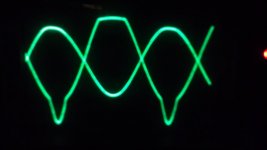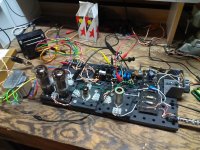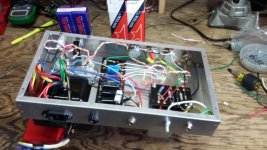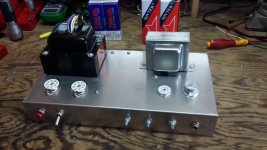Already having more scratch-built and modded tube amps sitting around than I have guitars (or hands) to play them, Has anyone built a fender/AC/Gibson/?? clone with a switch on the PI and P-P circuits, so all you have to do is swap a pair of tubes and flip a switch to go from one tube type to the other? I'm still looking at schematics for both tubes.... can either utilize the LTP PI? Or the Cathodyne? Would go fixed bias for either tube (and expect to have to switch it as well). PT and OT would be sized for 6L6. Thanks!
Looks like I can use the HotRod Deluxe PI and power circuit, and just switch the proper bias resistor for the 6V6 or 6L6. Will set the B+ a bit hot for a 6V6, and take whatever extra power the 6L6s give me. Any comments?
Looks like I can use the HotRod Deluxe PI and power circuit, and just switch the proper bias resistor for the 6V6 or 6L6. Will set the B+ a bit hot for a 6V6, and take whatever extra power the 6L6s give me. Any comments?
If I recall they have bias problems with these series of amps to begin with.
If you are going to use a 6V6, then set bias properly for that tube.
I think what you want to do is use the sections from the HOT ROD
Deville, the 6L6 amp. Then when you go to change tubes us the
JJ 6V6 (the are strong and will take the high voltage), and bias them
to spec.
If you want to fool around with a switch for bias that is okay too.
Just start with a beefier power tranny and output tranny for the 6L6,
so when you switch to the 6V6 you won't have a longevity problem.
Going from a less robust 6V6 to start with and going to 6L6,
you can have some problems with it frying.
Hope that helps.
Note, you cathode bias them, and switch between bias circuits,
which will be simpler for you in the long run.
Good suggestion, cathode bias eliminates the DC supply for fixed bias. And yes, the 6L6 Deville design. I plan on using the Weber W02279798INT PT, has many B+ taps and a 45VAC tap. Is a Bassman replacement. I check all my power tubes with a 1ohm on the plate, so will know where they're running, and an oscilloscope to look at how the PI is performing. I'd like to try a cathodyne, but don't know if it will drive the 6L6s. A cathode follower stage before it may help. I have a breadboard I can test configurations on. Thanks again!
Attachments
Last edited:
Good suggestion, cathode bias eliminates the DC supply for fixed bias. And yes, the 6L6 Deville design. I plan on using the Weber W02279798INT PT, has many B+ taps and a 45VAC tap. Is a Bassman replacement. I check all my power tubes with a 1ohm on the plate, so will know where they're running, and an oscilloscope to look at how the PI is performing. I'd like to try a cathodyne, but don't know if it will drive the 6L6s. A cathode follower stage before it may help. I have a breadboard I can test configurations on. Thanks again!
Oh, yes, a cathodyne will drive them. I have seen hifi amps with this configuration
I'm now leaning towards utilizing the Bassman AB165 preamp (normal channel only), and the AA864 power section. But...if I use a cathodyne PI, and use the spare triode in the preamp, it will save a tube... With diode rectification, that means only 4 tubes. Want as simple and compact design as I can get.
Why not build something simple like a tweed Deluxe. I have a clone that allows me to swap between 6V6s and 6L6s as well as between 5Y3, 5V4 and 5AR4 rectifiers. The beauty of this is it's self-biased so there's no fussing when tubes get swapped. I suspect this amp will take 5881s as well. (The clone I have was built by Blankenship Amp Repair out in your neck of the woods).
My last build started out as a 5E3 Deluxe (Tweed), and changed to a Princeton after I changed to fixed bias (adjustable) and added tremelo.... It doesn't have the PT or OT to handle 6L6s. I also want to play with the long-tailed-pair phase inverter (rather than the Cathodyne in the 5E3). Have it on breadboard now, which lets me experiment (what I like most about building tube amps!). Will try self-biasing tho, just to see how much "fussing" it eliminates! Thanks for the suggestion.
NFB wiring with a multi-tap OT secondary...
Summer has interrupted my finally putting my awesome sounding "Breadboard Bassman" clone into a proper chassis, but it's happening! Chose to do a "Mono-block" type build, and is almost done. QUESTION: My OT has 8,4,2 ohm secondary taps, and have wired it to a rotary switch. How to wire up the NFB? Worked great on the breadboard, wired to the 4-ohm tap to a 4 ohm load (2x12). But if I'm switching cabinets/load impedances, do I need another "gang" on the rotary switch to switch the NFB as well? Or leave it on one sec winding, regardless of the winding selected for the speaker. OR, switch it independantly from the speaker rotary switch??? Like, use the 4-ohm sec for a 4-ohm speaker, but use the 2-ohm winding for the NFB...?? Thanks!
Summer has interrupted my finally putting my awesome sounding "Breadboard Bassman" clone into a proper chassis, but it's happening! Chose to do a "Mono-block" type build, and is almost done. QUESTION: My OT has 8,4,2 ohm secondary taps, and have wired it to a rotary switch. How to wire up the NFB? Worked great on the breadboard, wired to the 4-ohm tap to a 4 ohm load (2x12). But if I'm switching cabinets/load impedances, do I need another "gang" on the rotary switch to switch the NFB as well? Or leave it on one sec winding, regardless of the winding selected for the speaker. OR, switch it independantly from the speaker rotary switch??? Like, use the 4-ohm sec for a 4-ohm speaker, but use the 2-ohm winding for the NFB...?? Thanks!
Attachments
From what I have seen, the NFB is going to stay on one tap. It is sending back a voltage signal that will stay in proportion, to your LTP or driver stage. The secondary winding tap that connects the speaker will reflect the correct load back to the power stage, and because the tap with the NFB loop is connected to the secondary too, all will remain constant WRT what the power tubes and driver are ''seeing''.
Nice build by the way! Just also to say that is what I have seen, and yes picking the ''ideal'' tap for your NFB resistor, is a matter of taste preference. And there is nothing wrong with having a separate switch or pot to vary the amount of NFB..basically your last 2 question are THE mojo questions. How the amp is going to feel, how much NFB and how the taps of the transformers relate with the load on possibly other taps. The NFB loop sees its own tap which is signal coming from the primary, but also getting some reactive power back on that secondary winding from the speaker load. So NFB tap choice and speaker tap can make some differences.
I've found I need NFB to tame the breakup...with no resistor at all. And need a 12AT7 for the two gain stages. An AX7 makes it squeal. Raised the grid stopper to the PI from 220K to 1Meg as well. Using 1500R/25Mfd on both preamp cathodes, tone stack is std fender.... Just want it clean, not too dirty....
I've found I need NFB to tame the breakup...with no resistor at all. And need a 12AT7 for the two gain stages. An AX7 makes it squeal. Raised the grid stopper to the PI from 220K to 1Meg as well. Using 1500R/25Mfd on both preamp cathodes, tone stack is std fender.... Just want it clean, not too dirty....
Get more/too much NFB going it's all Sluggish/slow/flattening like though.
Thanks! I'm gonna put my scope on it, stage by stage, and see where I need to find more headroom. Wonder if a cathode follower stage might smooth things out. Some Bassmans used them. Something about matching impedance to the PI...?
Thanks! I'm gonna put my scope on it, stage by stage, and see where I need to find more headroom. Wonder if a cathode follower stage might smooth things out. Some Bassmans used them. Something about matching impedance to the PI...?
Yeah definitely play around with the CF
- Status
- Not open for further replies.
- Home
- Live Sound
- Instruments and Amps
- 6V6/6L6 Switchable Guitar Amp




